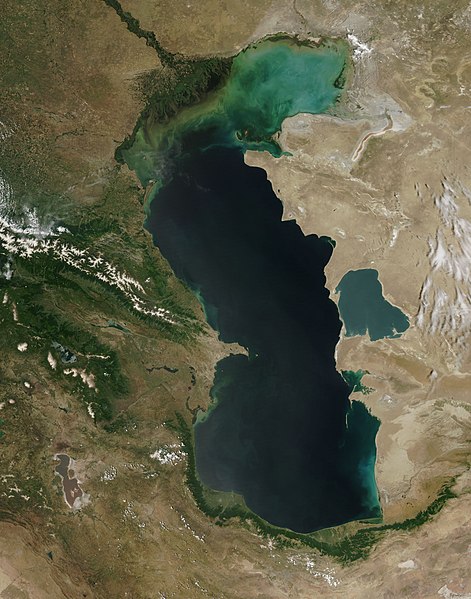Fajl:Caspian Sea from orbit.jpg

Nav dijə kardej pamjə: 471 × 599 piksel. Čo iznon: 188 × 240 piksel | 377 × 480 piksel | 603 × 768 piksel | 804 × 1,024 piksel | 1,609 × 2,048 piksel | 4,400 × 5,600 piksel.
Ce fajli original (4,400 × 5,600 пиксел, фајли памјә: 3.44 MB, MIME тиспир: image/jpeg)
Fajli tarix
Fajli syftə varianti vinde bə taryx/vaxti egətən.
| Tarix/Vaxt | Gədəlijə šikil | Pamjəjon | Ištirokəkə | Komment | |
|---|---|---|---|---|---|
| ysətnə | 13:16, 14 Ijun 2010 |  | 4,400 × 5,600 (3.44 MB) | Originalwana | higher res |
| 19:10, 8 Fevral 2005 |  | 550 × 700 (67 KB) | Pixeltoo | Caspian sea by space Nasa |
Fajli oko doj
2 səhifon oko dojdən ym fajl:
Fajli umumi oko doj
Ym fajl oko doə bejdə by vikijonədə:
- Oko doə bejdə af.wikipedia.org
- Oko doə bejdə als.wikipedia.org
- Oko doə bejdə am.wikipedia.org
- Oko doə bejdə ang.wikipedia.org
- Oko doə bejdə an.wikipedia.org
- Oko doə bejdə arc.wikipedia.org
- Oko doə bejdə ar.wikipedia.org
- بحر قزوين
- ويكيبيديا:صور مختارة/الفضاء والكون/نظرة إلى الخلف
- ويكيبيديا:ترشيحات الصور المختارة/بحر قزوين
- ويكيبيديا:صورة اليوم المختارة/ديسمبر 2016
- قالب:صورة اليوم المختارة/2016-12-23
- مستخدم:قائمة أكبر البحيرات والبحار في المجموعة الشمسية
- ويكيبيديا:صورة اليوم المختارة/يوليو 2020
- قالب:صورة اليوم المختارة/2020-07-16
- ويكيبيديا:صورة اليوم المختارة/يوليو 2023
- قالب:صورة اليوم المختارة/2023-07-26
- Oko doə bejdə arz.wikipedia.org
- Oko doə bejdə ast.wikipedia.org
- Oko doə bejdə as.wikipedia.org
- Oko doə bejdə av.wikipedia.org
- Oko doə bejdə azb.wikipedia.org
- Oko doə bejdə az.wikipedia.org
- Oko doə bejdə bat-smg.wikipedia.org
- Oko doə bejdə be.wikipedia.org
- Oko doə bejdə bew.wikipedia.org
- Oko doə bejdə bg.wikipedia.org
- Oko doə bejdə bh.wikipedia.org
- Oko doə bejdə bn.wikipedia.org
- Oko doə bejdə br.wikipedia.org
- Oko doə bejdə bs.wikipedia.org
- Oko doə bejdə bxr.wikipedia.org
- Oko doə bejdə ca.wikipedia.org
- Oko doə bejdə ce.wikipedia.org
- Oko doə bejdə ckb.wikipedia.org
- Oko doə bejdə co.wikipedia.org
- Oko doə bejdə cs.wikipedia.org
Dijə karde končo umumi oko dojdən ym fajli.


